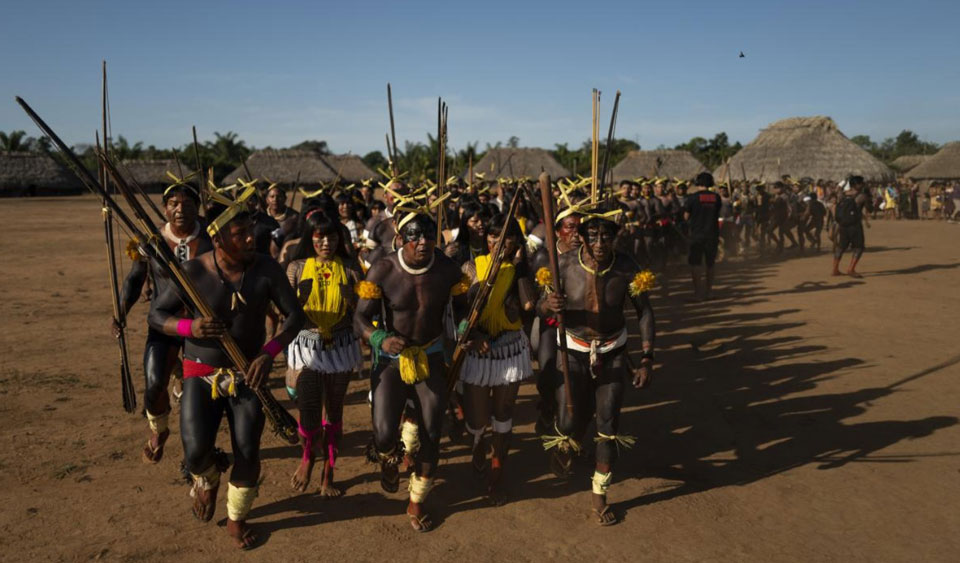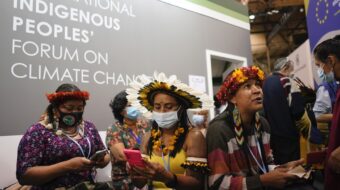
BRASILIA—In the last four years, threats on different fronts have intensified in the Xingu Basin. In 2021 alone, more than 1,753,700 acres were deforested in the region. That’s more than 194 trees felled every minute. Last year, deforestation in the protected territories increased by 30% from the previous year.
This alarming data comes from Sirad X, the remote monitoring system of the Xingu+ Network. The deforestation is mainly the result of different illegal activities, such as the falsification of property deeds, the stealing of wood and unlicensed mining, that put the integrity of the forest at risk as well as that of the peoples who inhabit it.
The situation is becoming increasingly dire with the imminent destruction of the Corridor of Xingu Protected Areas, the last barrier of protection in the Eastern Amazon.
“We Mebengokre people lived in the middle of the wealth. Our people put this wealth of food to good use—fishing, hunting, planting manioc, planting our food—this is what our people do. Our people did not have this custom that kuben [whites] have of not looking to others, not helping others. Many of you know what I am speaking about. Very, very rich kuben and poor, very poor kuben who live in favelas. Kuben are like that, people who don’t have good houses live near people who have big houses, beautiful houses,” Megaron Txucarramãe, the Kayapó chief said recently.

Megaron and leaders of 25 Indigenous peoples and traditional communities from the region were at the 5th Meeting of the Xingu+ Network, in the Khikatxi village, Xingu Indigenous Territory (XIT). The Khisedje hosted their relatives from the 9th to the 14th of May 2022.
With their households, food and cultures violated, the Xingu peoples see themselves as threatened by aggression on various fronts. In this hostile context, their union is the main path in the struggle for territorial protection. Their pact for life is embodied in the Xingu+ Network connection between the peoples of the Xingu and their partner civil organizations. The Manifesto of the Xingu+Network can be read here.
At the meeting, one priority was to feature young Indigenous and riverbank people, who come full of new knowledge—ready to engage and join the struggle at the side of the older ones. Mitã Xipaya, communicator of the Xingu+ Network, was presented by her first cousin, the tribal chief Juma Xipaya.

“Mitã is the fruit of a new generation, the one after mine. When I became the first female tribal chief of the Xipaya people and of the Middle Xingu, I said ‘I want youthful people at my side so they can learn.’ Because I was only chosen to be the leader because I had studied and had read all the National Indian Foundation (FUNAI) technical manuals and analyses. And Mitã is the product of all of that. If we want leaders committed to the future, we have to teach,” she said.
Ngrenhkarati Xikrin, from the Pot-Kro village in the Trincheira-Bacajá Indigenous Land, made an emotional appeal to all those present: “My father asked me to come here to ask for help. Because we do not know what to do any more. The men do not want us to participate. Today I am here because my father said, ‘You have to go and fight for yourselves, I am old. The time has come for you to share with your relatives outside and ask them for help. They are there.’ They are polluting our river, we are very impacted out there. Please, help us!” she exclaimed.

Maial Paiakan Kayapó, a young leader and pre-candidate for federal deputy of Pará [state], is also part of the youthful faction that is stepping up to the battlefront now that their elders need to pass the baton. “Since childhood, we have always been in the political world. That is why we are here and are going to continue this struggle, this is a legacy. We have to honor the name of our father. Unfortunately, COVID took my father and also many others when the government denied medical aid to various Indigenous peoples. It was very painful for our family and for the Indigenous movement in general. Always, when I travel, and I am in an IT [Indigenous Territory], I look at the forest and think about my father’s struggle. My father always said that it was not going to be easy but ‘you have to continue,’” she said.
Works of infrastructure or of destruction?
Another point taken up by those present were the serious impacts of the infrastructural construction projects on the Xingu and on its peoples. Doto Kayapó, leader of the Mekrãgnoti Indigenous Territory, spoke about the BR-163 and about the Ferrogrão, a railway that could bring even more devastation to the region.
“I remember when the governor [of Mato Grosso] called me and told me about this [railway] project. I said ‘I don’t decide by myself, because we have a protocol of consultation. This protocol says that no Indigenous person who works in the city can decide for us. If I am alone, I am nothing,’” he recalled.

According to the leader, the BR-13 road that links Santarém, in the west of Pará, to Cuiabá, Mato Grosso, has facilitated the entrance of alcoholic beverages in the territories, as well as increasing the number of vehicular accidents involving Indigenous pedestrians.
The opening of roads near the protected areas also facilitates the flow of illegal activities. “How do illegal mineral extractors enter these lands? By road. How are cattle transported? By road. The roads are the vectors of these problems. The moment has arrived to unite forces to ban these huge projects,” emphasizes Ianukula Kaiabi Suiá, president of the Indigenous Land of the Xingu Association (ATIX).
Roads like BR-163, BR-242, Ferrogrão, Belo Monte Powerplant (UHE) and the Belo Sun mining project, among various other examples, are undertakings with the ability to permanently destroy the entire ecosystem of the affected regions.
The way Indigenous people have discovered to resist large construction projects began with the construction of their Consultation Protocols. In these, they define the rules for consultation in each territory. See this special illustrated report about the consultation protocols of the Arara people.
Alliance against illegal mining
Illegal mining is one of the biggest threats to Indigenous people today. Apart from bringing the non-Indigenous presence into the territories, which has become even more serious in the pandemic, the illegal miners pollute the soil and contaminate the waters and the fish with mercury.
Created in December 2021, the anti-mining alliance of the Kayapó, Munduruku and Yanomami peoples was developed to unite the strengths of peoples affected by illegal mining activities. In the Indigenous Territories alone, the area occupied by illegal mining has grown 495% between 2010 and 2020. The Kayapó (Pará state), Munduruku (Pará state) and Yanomami (Roraima state) Territories are those most impacted, in that order, by the illegal search for gold.

“In the Kayapó Indigenous Territory we have seen an intensification of illegal mining,” Thaise Rodrigues, geoprocessing analyst for the Eye on the Xingu Observatory confirms. According to her, in the last four years, deforestation due to illegal mining was greater than the devastation registered in the preceding forty years. “More than 21,600,000 square acres of forest were destroyed to make room for illegal mining operations,” she exclaimed.
“Many leaders think that this kind of mining is normal. Mining kills people, kills children, spills blood. Our young people are being assassinated by illegal miners,” denounced Dario Kopenawa, vice-president of the Hutukara Yanomami Association.
“The Xingu+ Network pledged its support of the Alliance Against Illegal Mining of the Yanomami, Munduruku and Kayapó peoples. They were with us [at the May meeting in Khikatxi Village] and we heard from them about the suffering and grave crimes that have been committed in their territories because of the government’s inertia. We demand that the invaders be expelled and that the financiers of illegal mining operations and buyers of illegal gold be investigated and punished,” so says the manifesto the Xingu+ Network.
Carbon market and forest economy
The carbon market was also a theme of the Xingu+ Network meeting. It has to do with a system that intends to offset carbon emissions by nations or businesses and in this way alleviate their environmental impact.
For the peoples of the forest who seek ways of strengthening their economies and preserving nature, it may be a possible alternative. At the same time, the debate is complex, with a series of pros and cons. Members of the Xingu+ Network are betting on quality information as a tool that will help them find their place in the debate.
Ivaneide Bandeira, or Neidinha as she is known, a socio-environmental activist and director of the Kanindé Association for Ethno-Environmental Defense, explained each stage of the process of selling carbon credits to the Paiter Suruí people in Rondonia state.
“Non-Indigenous people do not always truly support the discourse about Indigenous autonomy, and we suffer accordingly. Another problem is that the illegal miners and lumber cutters are not interested in the carbon project and will influence their Indigenous employees to stand against the project and against its leading proponents,” she explained.
Another point addressed in the Xingu+ Network meeting was the forest economy incentive. Patrícia Cota Gomes, advocate and articulator of the Brazil Origins network, spoke about the importance of a better understanding of the legislation concerning extracting and exporting forest products and to guarantee that these processes are transparent, ethical and fairly remunerated.
“We were at a seed fair and a Kayapó man said that we needed to develop something that opened the crowns of the trees, because standing underneath them were the people who depend on, harvest and keep the forest standing. City people think that there is only the forest and its animals and forget that people live there as well. That’s where we got the idea to create technology and information as a way of bringing the forest and the city closer together,” Patrícia said.
Learn more about the Brazil Origins Network.


Translated from Portuguese by Peter Lownds. The original article from ISA can be found here.












Comments